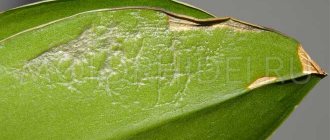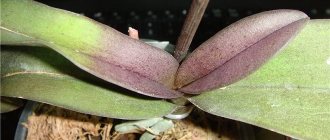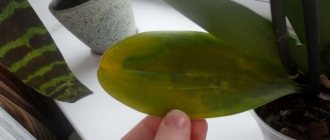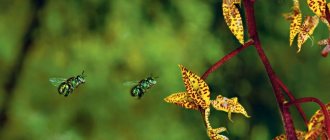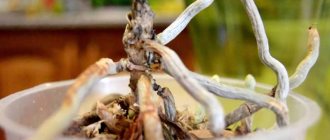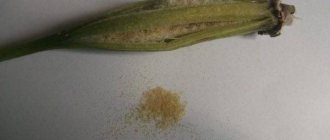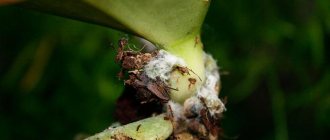It is not for nothing that orchids are not only exotic and rare plants. But they are also considered capricious tropical beauties .
Of the numerous species, lovers have a limited number of them. Not like the famous Orchid Park in Singapore.
Orchids are no longer something outlandish.
Just like it was just recently. But they still admire them. And not by chance. Their well-known centuries-old history confirms this:
- In Ancient China : Artists depicted Coelogina and Cymbidium;
- “The words of dear friends are the most delicate scent of orchids.” This is how the famous Chinese thinker Confucius wrote about orchids;
In ancient times, only rich and noble people could purchase orchids. - In writing, hieroglyphs were used according to their description : Orchid - Lan;
- Heavenly Orchid – Tin Lan;
- Orchid scent - Lan Fong.
But they are also susceptible to various diseases . Let's find out in more detail below how to save an orchid without roots and without leaves.
Causes of loss of roots and leaves
conditions for natural growth in a house or apartment . Even numerous hybrids specially bred for growing at home.
So we have to deal with various diseases. I don’t really want to lose quite valuable and expensive specimens.
The desire of flower growers to try to save even hopeless plants is understandable. It is important to accurately determine the causes of problems with roots or leaves.
And this can happen due to mistakes and miscalculations in caring for plants. Their inconsistencies with the type of orchid :
- Incorrect watering . Both extremes are harmful. Both drought and excessive watering;
- The quality of the substrate does not allow the roots to perform their functions. After all, even an ideal one becomes unusable after 3-4 years. And even earlier. Because of this, either drought or stagnation of moisture is formed;
- A cramped pot for an orchid. She has grown and needs a larger container. So he suffers in cramped conditions;
- Excessive temperature and humidity lead to diseases. As well as understated ones;
- Poor quality lighting does not provide the required amount of light. Such plants also fall under the scorching rays of the sun;
- Pests and diseases (especially fungal ones) can weaken plants. Without proper response, the plants will die;
- A strong passion for fertilizing , especially an overdose, will not do anything good for plants. Only harm;
- Damage to roots and leaves during transplantation;
- This most often occurs in the autumn-winter period.
An orchid may lose leaves due to improper care.
There is a close relationship between the condition of roots and leaves . As soon as problems form with the roots, they will immediately affect the leaves. The roots provide the leaves with the necessary amount of moisture. Healthy roots cope with this successfully.
Their inspection by experienced flower growers allows them to detect dried and rotten ones . The condition of the plants and your conditions determine the methods used to save orchids. You need to know them in order to skillfully apply them.
How do you know that the rhizomes have begun to deteriorate and that resuscitation is needed?
Problems with the root system affect the entire plant. Root rot can be suspected based on the following signs:
- the leaves turn yellow, become covered with brown spots, become limp and die one after another;
- buds and flowers quickly fall off;
- The stem wobbles a lot when moving the pot.
If these symptoms appear, you need to check the condition of the root system. To do this, the plant is removed from the pot and inspected:
- Healthy roots have a whitish or greenish color and a dense, elastic texture.
- Rotting leads to changes in color and density. The roots become black or brown and easily crush when pressed. If you run your fingers over the root, your hands will become dirty with a black-brown mass, and all that remains of the root will be an inner vein that looks like a thread.
Application of root formers
Which ones are on sale?
What kind of drugs will not be offered to you for the rehabilitation of orchids. Especially the market. Be careful.
Specialists and flower growers do this more discreetly . They advise creating the conditions necessary for plants. And purchase such drugs in specialized stores.
How to apply it correctly?
Radifarm. Various herbal extracts:
- To stimulate root growth;
- Successful rooting of plants. And orchids;
- Improves survival rate during planting and transplantation.
One drop of product is enough for one liter .
Kornevin. Hormonal biological product. Root formation stimulator:
- Dry powder : Mix with activated carbon in equal parts. With fungicide – 1 to 10;
- Dust the cuts. And shake any excess from the plants.
Kornevin can be used both in dry and soluble states.
Embiko. Liquid preparation. Has a whole range of microelements:
- 2 caps per liter of water is enough;
- Use boiled water;
- Orchids without roots are placed in this solution.
Master Tsvet or Gilea (Master Tsvet).
Ukrainian complex fertilizer:
- Dilute 2 caps of the product in boiled water;
- And place the plant in this solution.
Ribav-Extra. The drug is used to treat plants:
- Add 1-2 drops per 1 liter of water;
- Can be watered after 7-10 days. Or spray;
- Particularly effective during transplants and other stressful situations;
- Shows positive results in the formation of roots in phalaenopsis.
Flower growers also speak well of other drugs and fertilizers for resuscitating orchids:
- Zircon;
- Etamon (a fairly new drug).
Prevention measures
To prevent the orchid from rotting, it needs proper care. In summer, the plant is kept at a comfortable temperature within +22-25 °C, in winter - not lower than +18 °C. Diffused lighting should be provided throughout the year. Water the phalaenopsis with warm water as the substrate dries, do not allow liquid to get into the growth point. Fertilizers are applied only during the growing season, no more than once a week.
An orchid is a beautiful plant that can be destroyed by care errors. Root rot is not a death sentence, so you need to start treatment immediately. The sooner resuscitation procedures are completed, the easier the exotic flower will return to normal.
Features of foliar feeding
Alternate foliar feeding root feeding:
- Hold them in the evening;
- Experts recommend using Doctor Foley Orchid;
- Before spraying the leaf, slightly moisten the substrate;
Succinic acid is often used for foliar feeding. - Regular succinic acid is often and effectively used for roots. Flower growers recommend wiping the leaves (top and outside) with a cotton swab. Pre-moisten it in succinic acid dissolved in water.
One tablet per glass of water . To increase immunity in plants.
Effective compositions for resuscitation
Rotten roots on orchids need to be carefully trimmed. Treatment with special preparations helps treat the plant. To prevent microorganisms from developing resistance to the components, it is necessary to alternate products. Florists recommend changing medications every 3 procedures.
Antibiotics
Fitolavin is a complex drug that is used to destroy bacterial infections and fungi on an orchid. The product kills the pathogen and protects the plant for 20 days. To prevent pests from becoming accustomed, antibiotics should not be used more than twice every 60 days. The affected specimen is soaked in the solution for 30 minutes, the cut areas are treated or sprayed with a spray bottle.
Fungicides are designed to control fungi. If the plant gradually dies, then a strong drug will help stop the rotting.
- Systemic Fundazol penetrates through the vessels into the orchid tissue, kills pathogens, but is addictive.
- Maxim-Dachnik acts locally and protects phalaenopsis from diseases for 2 months.
Folk remedies
Plant-based recipes do not help with rotting roots. Activated carbon powder and cinnamon do not stop the destruction, sometimes even worsen it. To quickly cure an orchid, you need strong chemical fungicides. Folk remedies will drive away insects that weaken the flower. For spraying, it is better to make decoctions from:
- chamomile pyrethrum;
- tobacco dust;
- wormwood.
Do I need to remove the peduncle?
The orchid peduncle develops successfully and forms the buds of a healthy plant due to the roots and leaves :
- But if everything is not in order with them, then they cannot ensure full development of the peduncle;
- Experts advise cutting off the peduncle, depending on the condition of the orchid itself. But only the apical part;
- A reanimated orchid needs strength to restore its roots and leaves. Then the flowers will grow;
- But the plant may die. If he cannot cope with the provision of a peduncle. You decide.
Caring for a wilted plant
From the information above, we can conclude that it is quite possible to restore a dried orchid, but more attention should be paid to a withering crop, and then resuscitation will not be needed at all (Figure 6).
First of all, you should remember that a flower tolerates a slight drought better than excessive watering. To plant it, it is better to choose a transparent pot with ventilation holes. This will make it easier for you to control the optimal watering time.
Figure 6. A sluggish and weak flower requires increased attention from the owner
A wilting plant should be carefully examined. If there are visible signs of rot on the roots, it is better to transplant the flower into a pot with fresh substrate and not water it for several days. If the leaves begin to wither and turn yellow, the crop may have received sunburn, and it is better to move it to a less lit place.
Detailed instructions for resuscitating an exotic orchid are given in the video.
Is it possible to grow an orchid from a leaf?
- The leaves do not have a growing point . And it is impossible to grow them from a leaf. That's what the experts say;
- Can. Confirmed by amateur flower growers. They do it and show it.
An orchid can be grown from a single leaf.
The result of patience and perseverance :
- Water in container;
Growing a single leaf orchid requires patience. - The leaves were placed in water;
- The bases of the leaves are not immersed in water.
How to prevent Phalaenopsis from dying?
Careful adherence to recommendations for living conditions and care rules helps prevent problems when growing orchids:
- Compliance with watering standards. Phalaenopsis is a special flower that needs to be “watered” periodically. The next portion of moisture is added to the substrate only after the roots have absorbed the previous one. The root system must breathe, so it cannot constantly be in water.
- Providing intense lighting for at least 12-14 hours a day. Without a large amount of scattered sunlight, the plant loses its immunity. The roots weaken and cannot provide it with nutrients.
- Proper feeding. The main enemy of the orchid, which leads to rotting of the roots, is an excess of nitrogen. Fertilizing is carried out taking into account the phase of vegetative development of the plant. In this case, the dosage is reduced by 2-3 times to avoid overfeeding.
- Maintaining a humidity level of at least 60%. If there is not enough moisture in the air, the pot with the plant is placed on a tray with expanded clay. It must first be filled with water, an automatic humidifier must be installed in the room, and additional spraying of the leaves and roots should be carried out.
You shouldn’t throw away a limp, dried out or even rootless orchid. With some effort and patience, she can be saved. A life-loving flower will “take advantage of the chance for salvation,” the main thing is to choose the right method. Before using any method of resuscitation, you should first familiarize yourself with the recommendations of specialists and experienced flower growers. Wrong actions in this situation can aggravate the deplorable condition of the plant.
5/5 — (1 vote)
Root growth in children
In most cases, orchid babies also form roots . There are cases when such roots are missing.
Few options:
- You can continue care and wait for the roots to appear;
- Or you can stimulate their appearance : Equip a nest of damp moss at the base of the baby. And make a neat wrap of cling film;
- Reinforce it with thread;
- If it is on a peduncle, install an additional stick;
- Ventilate daily;
- Spray with Kornevin.
Pest and fungal disease control
Whatever the disease - fungal, viral, bacterial, or pests, the orchid needs urgent measures to eliminate the causes and take measures to treat it.
Fungi are everywhere around us. And a huge number of them can parasitize on orchid roots. , a fungal infection can occur .
But in most cases this happens from excessive care:
- Overflow;
- Overfeeding with fertilizers;
- Or the desire to create tropical conditions.
The fight against fungal diseases is based on :
- Urgent plant transplantation;
- Removal of lesions;
- Treatment of cut areas;
- And planting in a new pot with high-quality treated soil.
In case of severe damage, experienced orchidists recommend using antifungal drugs - for example, Mikosan.
Pests contribute to the appearance of rot on orchids.
If pests appear and their numbers are small, it is quite possible to get by by immersing the root part in water for a while. In advanced situations with a massive accumulation of pests, replanting with treatment of the root part with fungicides and a change of substrate is necessary.
The main pests that attack the root system of orchids are mealybugs and scale insects.
They not only weaken the plant, but also create favorable microflora for fungal infections.
We should also not forget that if the orchid is missing, but the root is alive, it can also be revived.
Additional resuscitation measures
It is advisable to strengthen a reanimated plant located in a greenhouse or flowerpot without a substrate using the following manipulations:
- daily soaking of the neck with the remains of the rhizome in a nutrient solution for 2-3 hours (in a greenhouse - once every 10-12 days);
- wiping the root collar and remaining leaves with a cotton pad or sponge soaked in a stimulating solution;
- bathing in warm water with dissolved vitamins, fertilizers, glucose.
Orchids planted in a substrate are fed by irrigating the soil surface or by the foliar method, wiping the base of the stem and remaining leaves with a weak solution of fertilizers or growth regulators.
Typical mistakes of beginning gardeners
Very often, inexperienced flower growers listen to the advice of a neighbor/friend/colleague who supposedly heard that when caring for orchids it is necessary to take certain measures. Such advice may not only be ineffective, but also destroy the flower. What kind of advice is this? Which of them could be deadly?
| Operation / Its consequences and recovery methods | What can happen | What to do |
| Treatment of plants with greenery | The cuts will dry out | Use activated carbon instead of brilliant green |
| Lack of lighting | The plant will go dormant | Improve lighting, but don't overdo it. |
| Overmoistening | The root will begin to rot | Remove rot and replant the plant |
| Removing drying leaves | The plant may die | This is a sign that the plant lacks some substances for growth and life. It is necessary to water with water with vitamins and necessary elements. |
Diseased roots also differ visually - they will be much darker, almost black. But to conduct an examination, you need to remove the flower from the pot, rinse it with water to remove the substrate and dry it a little. If at least 75% of the root remains intact, the plant can be saved.


